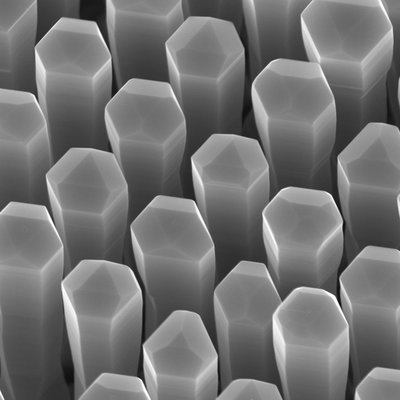Light-emitting silicon paves the way for photonic chips

Emitting light from silicon has been the ‘Holy Grail’ of the microelectronics industry for decades, as it would enable chips to become faster than ever. Now, European researchers have reported the development of an alloy with silicon that can emit light, and will begin work on a silicon laser to be integrated into current chips.
Every year we use and produce significantly more data — but current technology, based on electronic chips, is reaching its ceiling. The limiting factor is heat, resulting from the resistance that the electrons experience when travelling through the copper lines connecting the many transistors on a chip. If we want to continue transferring more and more data every year, we need a new technique that does not produce heat. Enter photonics, which uses photons (light particles) to transfer data.
In contrast to electrons, photons do not experience resistance. As they have no mass or charge, they will scatter less within the material they travel through, and therefore no heat is produced. The energy consumption will therefore be reduced. Moreover, by replacing electrical communication within a chip by optical communication, the speed of on-chip and chip-to-chip communication can be increased by a factor of 1000. Data centres would benefit most, with faster data transfer and less energy usage for their cooling system. But these photonic chips will also bring new applications within reach — think of laser-based radar for self-driving cars and chemical sensors for medical diagnosis or for measuring air and food quality.
Dropping electron emits a photon
To use light in chips, you will need a light source; an integrated laser. The main semiconductor material that computer chips are made of is silicon. But bulk silicon is extremely inefficient at emitting light, and so was long thought to play no role in photonics. Thus, scientists turned to more complex semiconductors, such as gallium arsenide and indium phosphide. These are good at emitting light but are more expensive than silicon and are hard to integrate into existing silicon microchips.
To create a silicon-compatible laser, scientists needed to produce a form of silicon that can emit light. That’s exactly what researchers from Eindhoven University of Technology (TU/e) have done. Together with researchers from the Universities of Jena, Linz and Munich, they combined silicon and germanium in a hexagonal structure that is able to emit light — a breakthrough 50 years in the making, now published in the journal Nature.
Hexagonal structure
“The crux is in the nature of the so-called band gap of a semiconductor,” said lead researcher Erik Bakkers from TU/e. “If an electron ‘drops’ from the conduction band to the valence band, a semiconductor emits a photon: light.”
But if the conduction band and valence band are displaced with respect to each other, which is called an indirect band gap, no photons can be emitted — as is the case in silicon. “A 50-year-old theory showed however that silicon, alloyed with germanium, shaped in a hexagonal structure does have a direct band gap, and therefore potentially could emit light,” Bakkers said.
Shaping silicon in a hexagonal structure, however, is not easy. As Bakkers and his team master the technique of growing nanowires, they were able to create hexagonal silicon in 2015. They realised pure hexagonal silicon by first growing nanowires made from another material, with a hexagonal crystal structure. Then they grew a silicon-germanium shell on this template. Elham Fadaly, co-first author of the study, said, “We were able to do this such that the silicon atoms are built on the hexagonal template, and by this forced the silicon atoms to grow in the hexagonal structure.”
But they could not yet make these devices emit light, until now.

Silicon laser
Bakkers’ team managed to increase the quality of the hexagonal silicon-germanium shells by reducing the number of impurities and crystal defects. When exciting the nanowire with a laser, they could measure the efficiency of the new material. Co-first author Alain Dijkstra, responsible for measuring the light emission, said, “Our experiments showed that the material has the right structure and that it is free of defects. It emits light very efficiently.”

Creating a laser is now a matter of time, Bakkers claimed. “By now we have realised optical properties which are almost comparable to indium phosphide and gallium arsenide, and the materials quality is steeply improving. If things run smoothly, we can create a silicon-based laser in 2020. This would enable a tight integration of optical functionality in the dominant electronics platform, which would break open prospects for on-chip optical communication and affordable chemical sensors based on spectroscopy.”
In the meantime, the team is also investigating how to integrate the hexagonal silicon in cubic silicon microelectronics, which is an important prerequisite for this work.
Please follow us and share on Twitter and Facebook. You can also subscribe for FREE to our weekly newsletter and bimonthly magazine.
Light reshapes semiconductors for advanced optical devices
Researchers have shown how light reshapes Janus semiconductors at the atomic scale, enabling...
Novel method to grow ultrathin semiconductors on electronics
Researchers have developed a technique that could speed up the development of next-generation...
Blue LEDs developed to enhance display performance
Researchers have developed a new method for manufacturing light-emitting diodes (LEDs) that emit...




